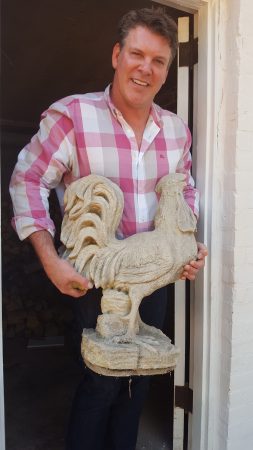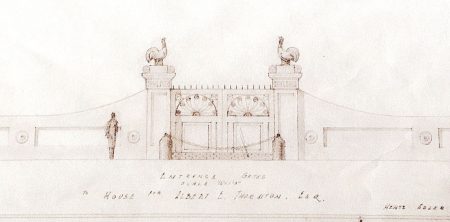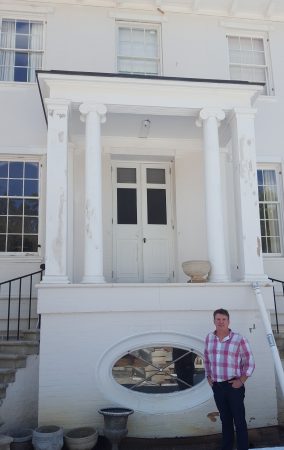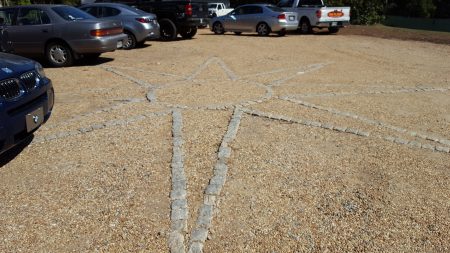The twin rooster statues were half-buried in dirt behind the historic Thornton House at 205 West Paces Ferry Road when Dr. Robin Fowler discovered them.
He rescued the statues, only later learning they may have once stood atop a decorative entrance gate designed, like the mansion itself, by Philip Trammell Shutze, a celebrated Atlanta architect best known for the Atlanta History Center’s Swan House.

Now Fowler and his wife Taylea aim to rebuild that entrance gate, just as they are preserving and rehabilitating the 1936 mansion—which is listed on the National Register of Historic Places—and its wealth of historical and decorative details. Fowler, a pain management physician, said he didn’t know about some local history organizations or preservation tax credits. Instead, his preservation work is driven by that instinct that led him to save the statues.
“I’m not a history buff. I have to think a minute to tell what year World War I and World War II were in,” Fowler said during a recent walk through the house and its grounds. “It just feels wrong to destroy something that has flavor and stories and significant history just to put something new in its place [and] just because it’s the easy way out.”
That attitude has not always prevailed in Buckhead, where older homes are often demolished for new, larger replacements. Preservationists were outraged early this year when another Shutze-designed house, located on Tuxedo Road, was torn down for such a project.

Meanwhile, the Fowlers have quietly carried out rehab work on the Thornton House since buying it in April 2015. Such preservation groups as the Buckhead Heritage Society were unaware of the work and say they can’t comment on its particulars.
But Sheffield Hale, president and CEO of the Atlanta History Center, welcomed the news of the house’s rehabilitation. He said he has his own “personal history” there, as family friends in 1988 threw him and his wife Elizabeth an engagement party at the house.
“It’s a wonderful house. … I think it’s wonderful that original details are being emphasized,” Hale said.

Robin Fowler pointed out a bevy of such details during the tour of the house. There’s the cobblestone starburst in the driveway, part of a star theme that carries through the house’s windows and other features: a dark wooden front door carved into a graceful curve; a series of decorative medallions on the foyer walls that, Taylea Fowler guesses, depicts the stages of family life; a rear portico with columns and a sweeping double staircase that Hale likens to “the Swan House in reverse,” as a mansion with a rear façade more dramatic than its front.
The house had sat empty and bank-owned for five years, Robin said, before he and Taylea bought it, moving in from Buckhead’s Ritz-Carlton Residences. He had no idea of the house’s historic status until seeing it in the coffee table book “Classic Atlanta,” which a real estate agent displayed in the foyer during sales tours.
Even then, the preservation work came more as a reaction to contractors’ suggestions. Early on, an architect recommended energy-efficient windows to replace the 1930s originals, with their single-pane glass and rope-and-lead-weight pulley systems.
“‘I don’t want any of that. I want it like it is,’” Fowler recalled responding. “I want to keep the house in the flavor of the way it was intended to be.”
Seeing the craftsmanship of the windows led him to start appreciating the house’s history and quality. “The more I started getting into the bones of the house, the more my interest climbed,” he said.

While Fowler had no preservation background, he likes construction. He once worked in contracting and his dad was a plumber. Growing up in rural Alabama, he developed an appreciation for old farmhouses. He said he carried out one prior restoration project of a different sort: the 1965 Ford pickup truck his dad used to drive to plumbing calls.
Fowler also happens to have the money for such extensive rehabilitation. He had budgeted $1 million to redo the house. So far, he said, “My $1 million has turned into 5 or 6 million.” That includes updating a 2009 wing, added by the previous owner, with such amenities as a sauna.
Not everything could be saved as-is, including a collapsing roof on an east wing. But the work includes historically sensitive interior redecorating, such as a dining room done in 1930s style wallpaper. An owner of the Calhoun House, another surviving Shutze mansion in Buckhead, is advising the interior decoration.

Fowler said the rehabilitation has brought many pleasant surprises, like finding copper hidden under paint on the roof cladding and a decorative pineapple sculpture. “It seems like a crime” the metal was painted over, he said, calling it a “treasure waiting to be uncovered.”
Another surprise was going to the History Center with his young daughter to research the house, mostly for fun, and discovering its original house and landscape blueprints on file. The documents included a hand-drawn design for the entry gate, topped with what appear to be those mysterious rooster statues.
“A small project turned out to be a much bigger project,” he said.

1 ❤ that you’re leaving the original windows.